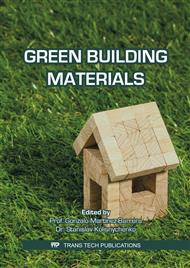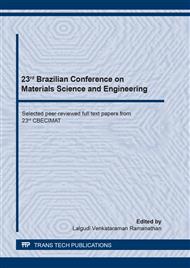p.196
p.202
p.207
p.215
p.221
p.227
p.233
p.239
p.244
Limestone Waste Incorporation in Clayey Mass for Rustic Ceramic Tiles Manufacturing
Abstract:
In the south of Ceará (Brazil), Cariri region, there is a production center for roof tiles and bricks. At that same region, there has been an expressive mining of laminated limestone, known as Pedra Cariri (Cariri Stone), which has produced large amounts of CaCO3-rich waste, that causes undesirable impacts to the environment. This work aimed to analyze the feasibility of producing rustic ceramic tiles, made up of clayey masses used in the region with the addition of this waste, aiming at the diversification of red ceramic products in a sustainable way. The mixtures were pressed, fired in maximum firing temperature which varies from 750° to 1150oC and had their physical-mechanical characteristics tested. The results indicated that the clayey mass is composed of kaolinite, feldspar and quartz, while montmorillonite and/or vermiculite is only found in roof tile clayey mass. The waste is mainly made of calcite. In general, the values of water absorption were compatible with porous rustic ceramic tile and the addition of Pedra Cariri waste provided lower values of firing shrinkage as well as the increase of the flexural strength. The samples of roof tile clayey mass (10% of waste at 850°C and at 1150°C) obtained physical-mechanical property values that match Brazilian technical norms to BIII type ceramic tile. Therefore, the mixture formulated with tile clayey mass and limestone waste presents potential to be utilized in the manufacture of ceramic roof tiles.
Info:
Periodical:
Pages:
221-226
Citation:
Online since:
October 2020
Authors:
Keywords:
Price:
Сopyright:
© 2020 Trans Tech Publications Ltd. All Rights Reserved
Share:
Citation:



